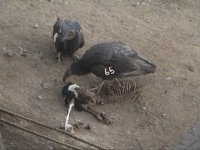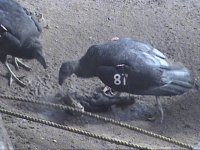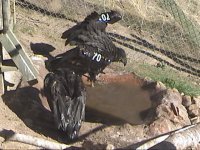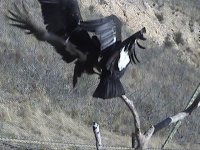[This is a continuation of my previous posts (‘Condor portraits’ and ‘Social condors’) in which I am sharing photos and information relating to the first group of California condors to be released at the Pinnacles National Monument condor reintroduction site.]
Condors are very social birds. Status (social ranking) among individuals is an important aspect of condor society and the birds seem consumed with this facet of their social lives. Dominance conveys various advantages over subordinate individuals such as priority access at a carcass or to a more desirable part of it, obtaining a more favorable spot at a night roost, etc. This overriding preoccupation with social status was ever evident among this first release group during their pre-release conditioning period as individuals seldom passed on an opportunity to assert their dominance over subordinates. In fact, the extent to which they engaged in this behavior was sometimes quite comical. It was so ingrained that upon observing the appearance of particular circumstances and situations the occurrence of such dominance related interactions could be predicted with a high degree of certainty and precision well before the incidents occurred (and oftentimes by 2-3 or more moves in a row as one incident might then trigger a chain reaction of dominance interactions).
During the period when construction of the new Pinnacles condor facility was being completed the 6 immature birds of the first release group and their adult mentor (named Hoi) were housed together in the facility at the Big Sur (Ventana Wilderness) reintroduction site (which is operated by the Ventana Wilderness Society). When they finally arrived at the completed Pinnacles facility a well-established dominance hierarchy existed within the group. As the sole adult in the group Hoi was easily the dominant individual and he ruled the roost. Period! Assuming this strong dominant role is one of the major functions of a mentor bird. Through Hoi’s dominance the immatures learned important lessons about condor society—in particular, how to properly function in the presence of such dominant individuals and how to operate within a dominance hierarchy in general. Hoi did an excellent job of keeping the youngsters in line. Aside from Hoi’s unassailable spot as the dominant individual within the group, a dominance hierarchy existed among the 6 immatures. However, this hierarchy was not static and some changes occurred in it during the pre-release conditioning period. For example, when the group first arrived 266 was the top ranking individual among the 6 immatures but he was later deposed and 287 then became the top ranking immature. Also, there were periods when the dominance hierarchy among the immatures was linear and periods when it was nonlinear. (Note that all 6 of the immatures were males so gender wasn’t a factor here.)
The predominant means by which individuals asserted their dominance was through displacements. Overall, these dominance interactions were peaceful in that they seldom involved any aggressive physical conflict. For the most part, during these displacement interactions the subordinate individual typically deferred to the dominant individual (even if grudgingly so) and just moved aside. Occasionally some snapping and brief pushing and shoving were involved, especially if the subordinate attempted to resist. Some photos illustrating these displacement interactions are included here.
Feedings at a carcass were a prime place for individuals to assert their dominance. One photo shows 265 moving in and displacing 286 from a carcass. A second photo depicts 287 stepping in and displacing 266 from a carcass. The facility pool was also a popular place for individuals to assert their dominance. Condors are fond of bathing and the facility pool became quite the place for social gatherings. Often if one individual went to the pool to bathe this typically served as a social magnet that would draw other individuals to the pool to bathe, this then commonly resulting in a condor pool party. The pool was basically just large enough for a single individual at a time to bathe. This being the case, more dominant individuals seemed to delight in displacing subordinates from the pool when the subordinate went in to bathe, especially if the subordinate was ranked just below it in the dominance hierarchy. A third photo shows 265 moving in and displacing 270 from the pool (270 is stepping out and deferring as 265 is getting ready to move in).
A fourth photo shows Hoi very physically displacing 270 from Hoi’s favorite perching spot on the snag. Whenever Hoi went onto the snag this was the spot that he nearly always chose to use and all of the immatures knew it. Thus, if an immature happened to be in his spot and saw Hoi come onto the snag or looking to do so that individual (on its own) would defer and vacate Hoi’s spot. And Hoi always gave them the time and opportunity to do so peacefully on their own. However, in this particular instance 270 was for some reason being stubborn and refused to defer. Hoi gave 270 much time to do so peacefully and even made clear his intentions to go to his spot by perching just below 270 and giving 270 time to move from his spot. Still, 270 refused to move. Finally, Hoi lost patience and put the youngster in his place by very physically muscling and shoving 270 off of his spot and off of the snag. [Note that Hoi was the perfect adult mentor. Though as an adult he had the strength to seriously harm or even kill an immature he was basically quite gentle with them but was nonetheless firm when he needed to be. In regard to displacements he always gave them time to defer on their own without him having to get physical or aggressive with them. Whenever he did have to resort to aggression and physicality he applied only just what was needed—he never overdid it and never harmed any of them.]
Condors are very social birds. Status (social ranking) among individuals is an important aspect of condor society and the birds seem consumed with this facet of their social lives. Dominance conveys various advantages over subordinate individuals such as priority access at a carcass or to a more desirable part of it, obtaining a more favorable spot at a night roost, etc. This overriding preoccupation with social status was ever evident among this first release group during their pre-release conditioning period as individuals seldom passed on an opportunity to assert their dominance over subordinates. In fact, the extent to which they engaged in this behavior was sometimes quite comical. It was so ingrained that upon observing the appearance of particular circumstances and situations the occurrence of such dominance related interactions could be predicted with a high degree of certainty and precision well before the incidents occurred (and oftentimes by 2-3 or more moves in a row as one incident might then trigger a chain reaction of dominance interactions).
During the period when construction of the new Pinnacles condor facility was being completed the 6 immature birds of the first release group and their adult mentor (named Hoi) were housed together in the facility at the Big Sur (Ventana Wilderness) reintroduction site (which is operated by the Ventana Wilderness Society). When they finally arrived at the completed Pinnacles facility a well-established dominance hierarchy existed within the group. As the sole adult in the group Hoi was easily the dominant individual and he ruled the roost. Period! Assuming this strong dominant role is one of the major functions of a mentor bird. Through Hoi’s dominance the immatures learned important lessons about condor society—in particular, how to properly function in the presence of such dominant individuals and how to operate within a dominance hierarchy in general. Hoi did an excellent job of keeping the youngsters in line. Aside from Hoi’s unassailable spot as the dominant individual within the group, a dominance hierarchy existed among the 6 immatures. However, this hierarchy was not static and some changes occurred in it during the pre-release conditioning period. For example, when the group first arrived 266 was the top ranking individual among the 6 immatures but he was later deposed and 287 then became the top ranking immature. Also, there were periods when the dominance hierarchy among the immatures was linear and periods when it was nonlinear. (Note that all 6 of the immatures were males so gender wasn’t a factor here.)
The predominant means by which individuals asserted their dominance was through displacements. Overall, these dominance interactions were peaceful in that they seldom involved any aggressive physical conflict. For the most part, during these displacement interactions the subordinate individual typically deferred to the dominant individual (even if grudgingly so) and just moved aside. Occasionally some snapping and brief pushing and shoving were involved, especially if the subordinate attempted to resist. Some photos illustrating these displacement interactions are included here.
Feedings at a carcass were a prime place for individuals to assert their dominance. One photo shows 265 moving in and displacing 286 from a carcass. A second photo depicts 287 stepping in and displacing 266 from a carcass. The facility pool was also a popular place for individuals to assert their dominance. Condors are fond of bathing and the facility pool became quite the place for social gatherings. Often if one individual went to the pool to bathe this typically served as a social magnet that would draw other individuals to the pool to bathe, this then commonly resulting in a condor pool party. The pool was basically just large enough for a single individual at a time to bathe. This being the case, more dominant individuals seemed to delight in displacing subordinates from the pool when the subordinate went in to bathe, especially if the subordinate was ranked just below it in the dominance hierarchy. A third photo shows 265 moving in and displacing 270 from the pool (270 is stepping out and deferring as 265 is getting ready to move in).
A fourth photo shows Hoi very physically displacing 270 from Hoi’s favorite perching spot on the snag. Whenever Hoi went onto the snag this was the spot that he nearly always chose to use and all of the immatures knew it. Thus, if an immature happened to be in his spot and saw Hoi come onto the snag or looking to do so that individual (on its own) would defer and vacate Hoi’s spot. And Hoi always gave them the time and opportunity to do so peacefully on their own. However, in this particular instance 270 was for some reason being stubborn and refused to defer. Hoi gave 270 much time to do so peacefully and even made clear his intentions to go to his spot by perching just below 270 and giving 270 time to move from his spot. Still, 270 refused to move. Finally, Hoi lost patience and put the youngster in his place by very physically muscling and shoving 270 off of his spot and off of the snag. [Note that Hoi was the perfect adult mentor. Though as an adult he had the strength to seriously harm or even kill an immature he was basically quite gentle with them but was nonetheless firm when he needed to be. In regard to displacements he always gave them time to defer on their own without him having to get physical or aggressive with them. Whenever he did have to resort to aggression and physicality he applied only just what was needed—he never overdid it and never harmed any of them.]







